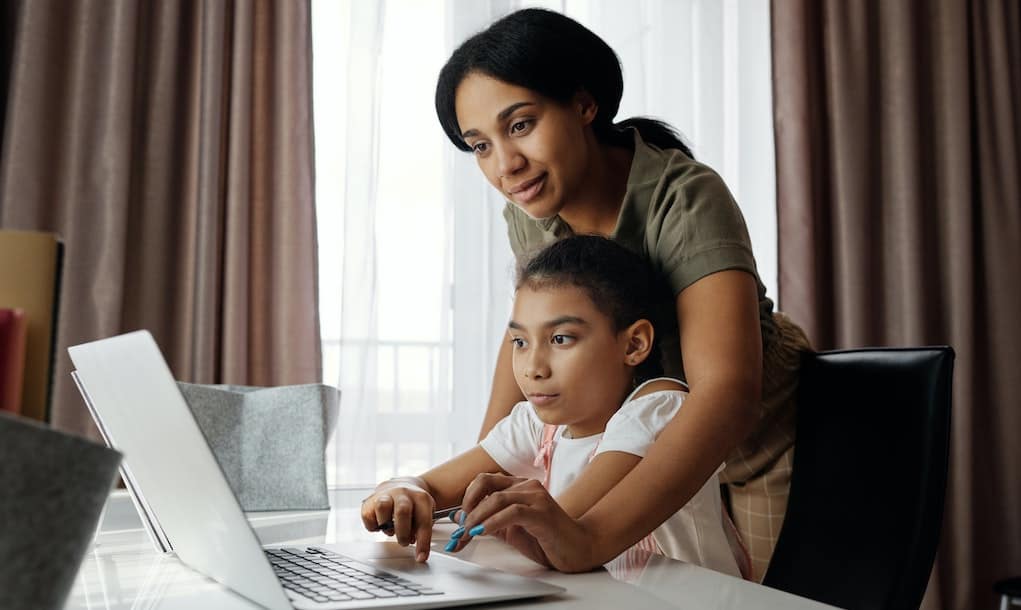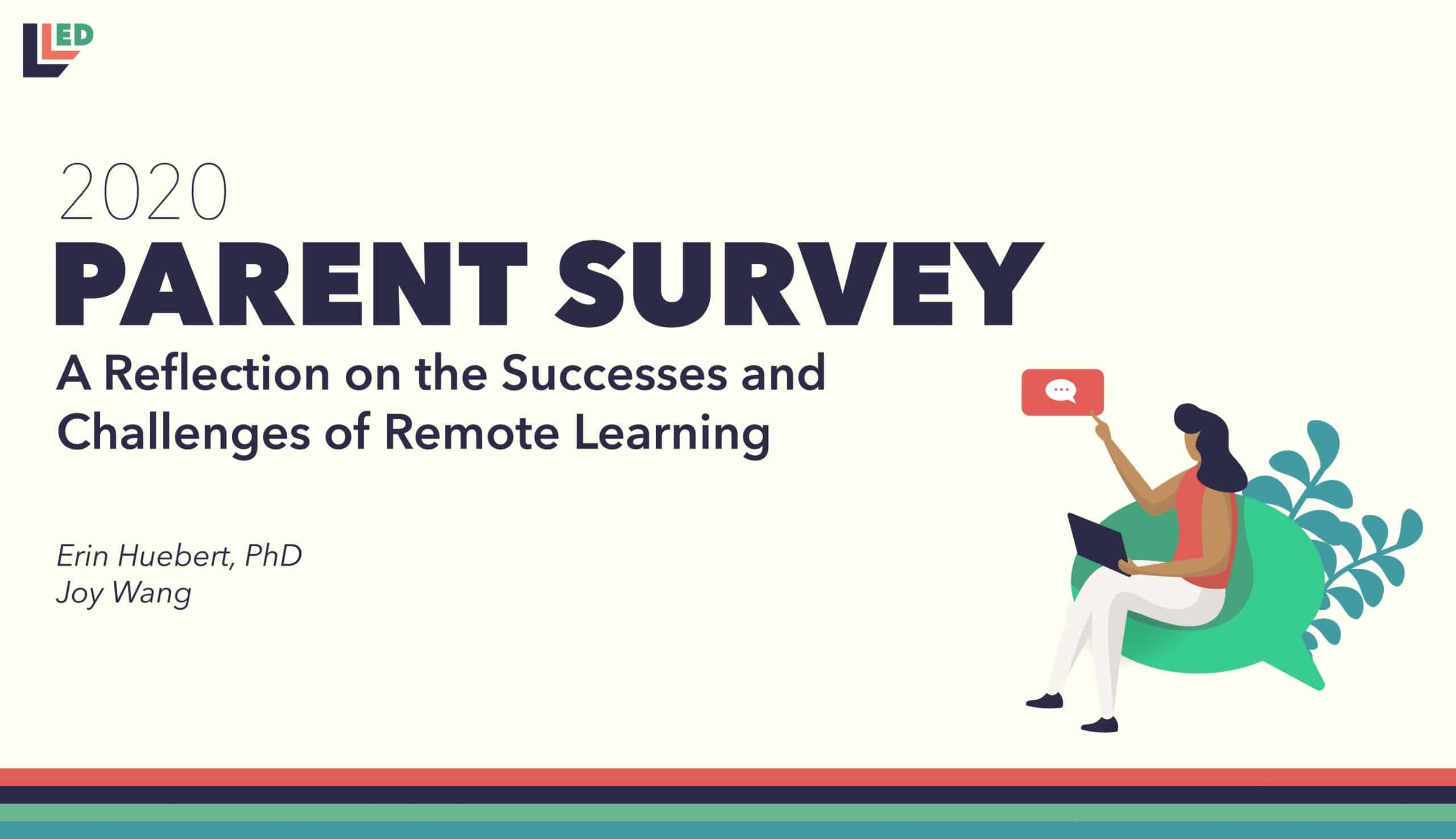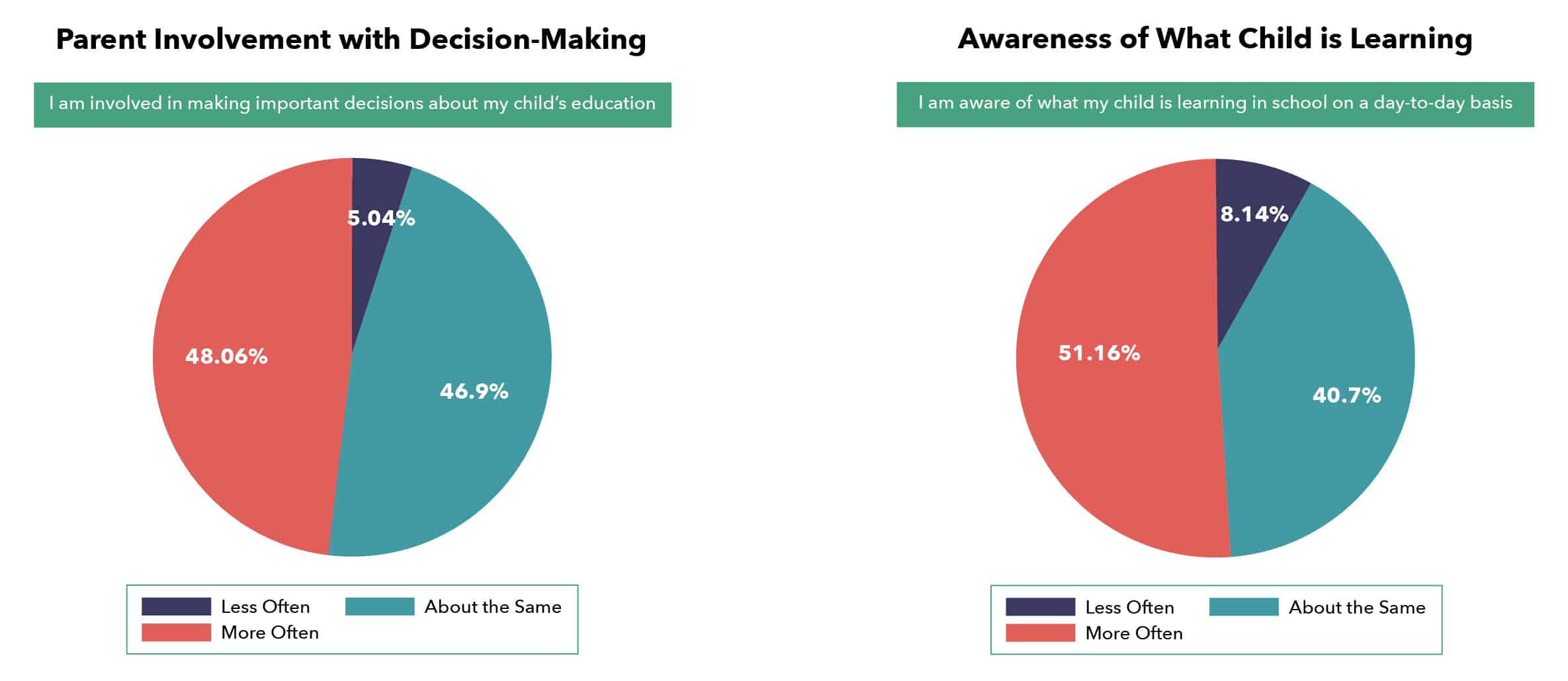5 Recommendations to Improve Remote Learning for Families

By: The LEANLAB Editorial Team
Defining the nuanced challenges that parents and caregivers are facing in 2020 is a big undertaking, but it merits our full attention before we can shift into problem-solving mode. In a year filled with so much uncertainty, the challenges parents face are fluid, shifting week-to-week and hour-to-hour. However, at LEANLAB Education, a nonprofit supporting education innovation, we know we can’t identify solutions to problems we don’t fully understand, which is why we prioritize getting close to the communities we serve—even in a world where social distancing is required—and why we surveyed more than 500 parents and caregivers to understand how they’re coping in the age of remote learning.
We wondered how parents and caregivers from different backgrounds were approaching remote learning; specifically how caregivers with differing geographical, racial, and economic backgrounds perceived and experienced remote learning. We found that a parent’s education level was one of the most salient factors in determining how prepared they were to deal with the challenges brought on by the transition to a digital learning environment. If education level truly shapes how people react to the world around them, it puts our vision into even sharper focus as we look to provide every child with equal access to an inspiring education.
The concerns parents and families have about their children’s education reach beyond the challenges brought on by remote learning. Concerns that were prevalent before the onset of the pandemic have only been exacerbated by its arrival. In our annual listening tour, family-to-school communication has consistently been a top stressor for parents and schools. This year, it intensified as the responsibility of overseeing their students’ day-to-day education has fallen more squarely on the shoulders of caregivers.
We’ve distilled our comprehensive report and parents’ advice on how to make a difficult transition a little easier for school communities. As COVID cases continue to rise here in Kansas City and across America, and as school leaders weigh the potential negative impact of no-win decisions, we hope they’ll leverage the crucial voices of parents in making those determinations.
Benefits of Remote Learning
1. More Frequent Communication Between Teachers and Families
- Teacher-parent communication is a key success indicator of at-home learning. In open-ended survey responses, many parents responded that teachers who reached out about missing assignments or provided clear to-do items helped make at-home learning successful. Parents appreciated the support of having a weekly overview of to-do items that clearly distinguished required work versus recommended, optional assignments. We found that 51% of parents were more aware of what their child was learning compared to at-school learning.
- Caregivers appreciated teachers who gave them access to a direct line to email and call with questions. When school administrators and teachers communicated clearly with parents about their expectations in a face-to-face virtual format, parent satisfaction was higher.
- Parents cited a desire to hear from teachers when their student was doing well, not just when their student was struggling. Of respondents, 40% of parents said teachers initiated communication with them more often than before COVID-19, and 35% of parents said they initiated communication with teachers more often than before. Black respondents, in particular, reported more confidence, involvement, and awareness during at-home learning than during at-school learning.
2) Increased Parent and Student Agency
We found that one benefit of at-home learning was children could adjust their learning schedules to what best suited their interests and needs. “We were able to structure learning around his interests, as well as find a more natural rhythm to the day. He loves to read at night before he goes to bed and likes to do math games first thing in the morning, as well as spend a lot of time playing outside. Being at home allowed us to have a more natural rhythm. It also allowed us to do more art, which he loves.”
Some parents were also able to spend time supporting their child’s academic interests, or helping their child tackle challenging subjects, with 48% of parents reporting that they’re more involved now than previous. One parent shared, “I discussed American history with my child and enriched his knowledge of history in the process.”
Remote Learning Challenges
1) Students Struggle with Motivation and Ability to Focus
One of the biggest challenges the survey reveals is a lack of student motivation and focus. Parents cited an absence of grades, resulting in their child not being incentivized to complete assignments. In the words of one parent, “Students were told that their grades would not drop. This gave my student zero motivation. My student did only what she had to, which was very little.”
Caregivers also commonly mentioned an inability to focus as a perceived challenge for students. “Uno de mis hijos necesita que alguien esté constantemente recordándole para que se mantenga enfocado en lo que tiene que hacer. A veces se distrae fácilmente con otras cosas en la computadora. Entonces era estar checando que hiciera su trabajo.” (Translated: One of my children needs someone to constantly remind him to stay focused on his assignments. He easily gets distracted with other things on the computer. Therefore, I have to keep checking on him, in order for him to complete his work.)
2) Parents Struggle with Limited Time and Capacity
Another major challenge was parent capacity and time, which was especially challenging for parents who were working a full-time job, and parents with younger children and/or multiple students in the household. One parent commented, “Trying to balance work and manage the kids’ classes is a huge challenge. If we only had to do one or the other, we could manage, but both are exhausting, and doing both well is just not possible.” Some parents, particularly for those with multiple children, lamented that the varying platforms and systems used by schools made supporting their children confusing and difficult.
There are also racial disparities in parent confidence to support their children in a school-at-home setting. For example, for Latinx parents, 17% felt less confident compared to when their child was in in-person school while only 9.86% of white parents felt less confident. Additionally, education level appears to be an indicator of capacity. Of those we surveyed, caregivers with more education (those with schooling beyond high school) felt more prepared to support their student at home, felt more comfort and confidence in using edtech tools, and were less concerned about their student’s educational progress.
3) Families Lack Access to the Tools They Need—Including the Internet
An important piece of understanding the parent experience with at-home learning is the impact of the digital divide, the gap between those with access to connectivity and technology and those without. A LEANLAB report from June 2020 illuminated the stark inequities in education among students throughout the Kansas City metro area as a result of the digital divide. As many as 20% of students across 22 school districts lack access to the Internet, and therefore miss out on the same virtual learning opportunities as their connected peers. Despite our earnest efforts to supplement our online survey tool with phone surveys, we were unable to capture the true effects of the digital divide on parent experience with at-home learning because of the medium of the survey and how difficult it is to connect with disconnected families. Only 20 out of the 516 respondents indicated that they lacked consistent and reliable internet access, and the survey significantly under-represents the sentiment from parents without access to the Internet.
Given these findings, we’ve drafted a few recommendations for schools, teachers, and parents.
5 Recommendations
1) Co-create personalized instructional goals for students
In surveys, 70% of respondents indicated that their child’s educational progress (or lack thereof) was a concern. However, perhaps caregivers, educators and school leaders need to work together to redefine what constitutes “progress” in the context of a global pandemic. The day-to-day experiences for families in 2020 are as unique as the U.S. population is diverse. If there was ever a time to abolish one-size-fits-most arbitrary goals for student achievement based on grade level, this is it.
An ideal scenario would be one wherein school leaders create opportunities for teachers and families to co-create customized, individualized learning goals for each student that are appropriately modified for the era of a global crisis and the context of remote education. When families buy into shared expectations, they’ll work in concert with educators to help their students meet new, modified and achievable goals.
2) Foster ongoing communication between educators and caregivers
Schools should prioritize and develop systems that create clear lines of communication between parents and teachers. Teachers need ways to source feedback from the home and vice versa to adapt and respond to student needs in real time. An ongoing feedback loop will help both families and educators adapt to rapidly-changing environments and help teachers feel confident the workload they assign is feasible for students and their families.
3) Set a learning schedule that allows for flexibility
One key method that helped make at-home learning successful for the families we surveyed was a well-defined study plan or schedule that still allowed for flexibility. In some instances, teachers helped create a schedule. In others, parents created one for their student. Either way, we found that predictable, yet flexible, schedules helped add structure and kept students focused and motivated. The key is building in a schedule that is flexible enough to meet the unique needs and time constraints of the students’ families.
4) Coach parents on edtech tools
Not only are schools constantly adopting new edtech tools, those tools are also constantly evolving. It’s challenging for educators to stay up-to-date on the myriad of tools in the classroom, let alone the parents. Without support on the platforms schools leverage in both an in-person, and especially a remote learning environment, parents are ill-equipped to support their students, which puts more burden on the educators. Schools should forge partnerships with their edtech providers to offer comprehensive and on-going support for parents (in multiple languages), on not just how to use edtech tools, but also on the desired student learning outcomes for each platform. By training parents in groups and putting more responsibility on the backs of edtech providers, educators can save time by fielding fewer one-off questions and leverage parents as a network of classroom aides to add to their capacities.
5) Collaborate with parents and give them agency
Schools should extend ongoing, at-home, collaborative learning opportunities with parents to support parents’ abilities to reinforce materials in the home setting and provide parents more agency in their child’s education. Many parents we surveyed reported having asked their student’s teacher for advice on how to tutor their kids, and reported finding that to be incredibly helpful.
School leaders should consult parents on important school decisions. For example, they should get feedback when they select edtech platforms to ensure that the solutions are user-friendly enough that parents, as well as teachers, can support students’ interaction with the tools. This will reduce stress and confusion for caregivers, students, and teachers alike.
In 2020, it takes an entire education ecosystem to produce a career-ready, socially responsible adult. The assembly-line, one-size-fits-most approaches of factory model schooling are antiquated in a brick and mortar classroom, but fall especially short in a remote environment. Parents, educators, and administrators need to collaborate and communicate frequently to make the constant adjustments and real-time decisions necessary to yield the best possible outcomes for each individual student.
More to Learn
Our in-depth report dives further into these successes and challenges, and provides more systemic findings on the variation in perspectives and experiences with at-home learning among parents in the Kansas City metro area. We outline some key takeaways and report on the data for schools and families to ensure that we can use the lessons we’ve learned in the past year to build a more equitable future for all students.
Yet, the report is just the first step in understanding the successes, challenges, and impact of at-home learning for local Kansas City parents. As the COVID-19 pandemic continues to keep many students out of traditional classrooms, it is important for parents and school communities to work together in a way that supports parents, students, and teachers. Further research is needed to evaluate the ongoing effect of at-home learning on student learning and social-emotional outcomes, as well as on teacher and family well-being.
For more, see:
- Parents as Essential Partners in Pivoting their Child’s Education & Fostering Remote Learning
- How We Can Support Educators and Parents in the Midst of ‘Crisis Schooling’
- Learning Coach Academy: Supporting the Role of Parents or Guardians in Remote Learning
Members of the LEANLAB Education staff contributed to this article. The report was prepared by Dr. Erin Heubert and Joy Wang. Dr. Heubert and Jorge Holguin collaborated on the survey design and distribution.
LEANLAB Education is a Kansas City-based nonprofit whose mission is to launch transformational education innovations that have a national impact. Their method is pairing under-resourced school communities with high potential education technologies to measure their impact in authentic classroom environments.
Stay in-the-know with innovations in learning by signing up for the weekly Smart Update.







Naomi Murphy
Thanks for such a great post. I found it really helpful as I am researching this topic currently. Would like to read more from your collection. Happy blogging.!